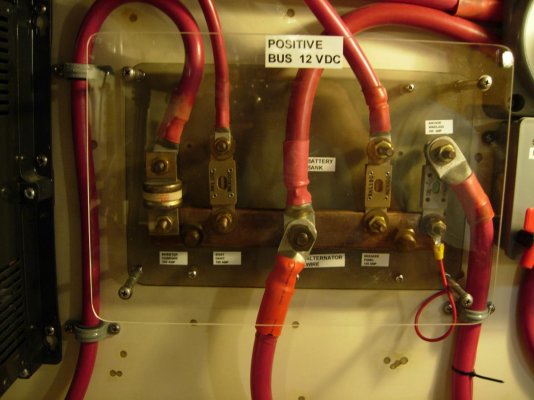jungpeter
Guru
A previous owner installed a Heart ECS 1800 inverter/charger on my Tolly 48 in the early 90's. The installation does NOT contain an inline fuse on the DC output side, despite Heart (and others) recommendation. I would like to clean up this installation by installing proper fusing on this circuit.
The Heart callout for fusing on the DC output of the inverter is a 200 amp Type-J slow-blow fuse. I'm unable to locate a suitable marine fuse holder for this type of fuse. And Type-J fuses don't appear to be common stock items in marine supply stores. Fisheries Supply, for instance, lists ANL, T, AMI, AMG, T, yada, yada, yada, but no Type-J.
Some marine professional electricians recommend a Type-T fuse for this application, which is not a slow-blow fuse.
So, I be conflicted on many fronts. Why fuse an inverter/charger on the DC output leg at 200 amps, when the rated output of the inverter is 65 amps DC? Shouldn't that be more appropriately fused at something like 100 amps, which is about 150% of output? And why a slow-blow fuse? Obviously to limit nuisance tripping, but ???
And, does anyone have a lead to a Type-J fuse holder for marine use? Maybe I'm trying to pick the fly poop out of the pepper here, and use of a readily-available Type-T fuse and holder is just fine. But inquiring minds wish to know....
Regards,
Pete
The Heart callout for fusing on the DC output of the inverter is a 200 amp Type-J slow-blow fuse. I'm unable to locate a suitable marine fuse holder for this type of fuse. And Type-J fuses don't appear to be common stock items in marine supply stores. Fisheries Supply, for instance, lists ANL, T, AMI, AMG, T, yada, yada, yada, but no Type-J.
Some marine professional electricians recommend a Type-T fuse for this application, which is not a slow-blow fuse.
So, I be conflicted on many fronts. Why fuse an inverter/charger on the DC output leg at 200 amps, when the rated output of the inverter is 65 amps DC? Shouldn't that be more appropriately fused at something like 100 amps, which is about 150% of output? And why a slow-blow fuse? Obviously to limit nuisance tripping, but ???
And, does anyone have a lead to a Type-J fuse holder for marine use? Maybe I'm trying to pick the fly poop out of the pepper here, and use of a readily-available Type-T fuse and holder is just fine. But inquiring minds wish to know....
Regards,
Pete


